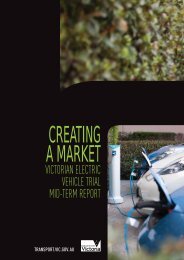Grain Logistics Taskforce Report - Department of Transport
Grain Logistics Taskforce Report - Department of Transport
Grain Logistics Taskforce Report - Department of Transport
You also want an ePaper? Increase the reach of your titles
YUMPU automatically turns print PDFs into web optimized ePapers that Google loves.
6.5 Track standardsVictorian regional rail freight trainstandards <strong>of</strong> 80 km/h (or less) at19 tonne axle loads (tal) have appliedfor over 40 years (the exceptionto this is intermodal trains on theMildura and Maryvale lines whichare allowed 20 tonne axle load).A 19 tonne axle load translates intoa 76 tonne gross wagon mass whichis generally a 55 tonne load for awagon with 21 tonne tare weight.In contrast, truck productivity since1995 has increased nearly 60%from 42.5 tonne gross six axlesemi-trailers carrying 28 tonnes <strong>of</strong>freight to 68 tonne 9 axle B-doublescarrying 44 tonnes <strong>of</strong> freight.The ARTC’s track standards are19 tal at 115 km/h, 21 tal trains at110 km/h (the general standard forinterstate intermodal trains) and 23 talat 80 km/h (eg heavy ore trains andloaded grain trains). A 21 tonne axleload wagon is 15% more productivethan a 19 tal wagon while a 23 talstandard provides a 30% productivityincrease compared to the regionalVictorian rail freight network. T<strong>of</strong>urther increase productivity and railfreight competitiveness the ARTC isincreasing the latter two standards bythe end <strong>of</strong> 2011 to 23 tal at 100 km/hand 25 tal at 80 km/h respectively onthe Melbourne – Sydney and Sydney– Whyalla corridors.<strong>Grain</strong> wagons with suitable capabilityare allowed to operate up to 23 tonneaxle load on the ARTC network intothe Port <strong>of</strong> Melbourne and Port <strong>of</strong>Portland, but the Geelong grain loopis presently restricted to 19 tonneaxle load despite connecting to theARTC network. A 50 wagon standardgauge 23 tal grain train using newwagons can transport 3,500 tonnescompared with 2,200 tonnes for a40 wagon 19 tal grain train usingolder wagons.Industry advice is that 19 tal broadgauge Victorian grain wagons couldbe increased to 21 tal subject totrack and bridge capability. Thiswould enable a 40 wagon grain trainto transport 2,500 tonnes ratherthan 2,200 tonnes with consequentbenefi ts for silo clearance.Although increased freight trainaxle loads require higher trackmaintenance costs, this needsto be compared with the lowerroad maintenance costs andimproved road safety arising frommode shift to rail from increasedrail freight competitiveness.6.6 Train and truck driversAn issue affecting both train and truck capacity isavailability <strong>of</strong> train and truck drivers. There is presentlya national shortage <strong>of</strong> both due partly to the time ittakes for them to become qualifi ed (18 – 24 months totrain a driver). The present shortage <strong>of</strong> train drivers isaffecting the rail industry’s ability to provide moregrain trains.However, there is a lag between demand fortrains and driver availability and even when they aretrained they are sometimes <strong>of</strong>fered jobs with othercompanies. The trucking industry has a similar problemin recruiting and training drivers and then havingbecome appropriately qualifi ed to drive grain trucks.It was suggested by industry that the criteria for thetraining and competency assessment <strong>of</strong> train andtruck drivers be reviewed by relevant licensing authoritiesand the <strong>Department</strong> <strong>of</strong> <strong>Transport</strong> to ascertain whetherthey could be streamlined to assist in addressingdriver shortages in each mode, but withoutcompromising safety.<strong>Grain</strong> <strong>Logistics</strong> <strong>Taskforce</strong> <strong>Report</strong> 21
















